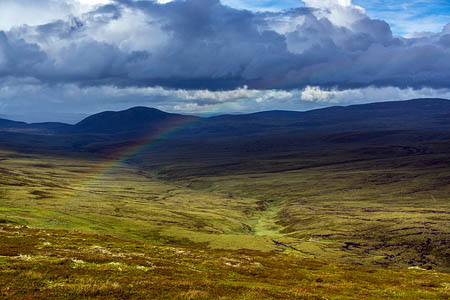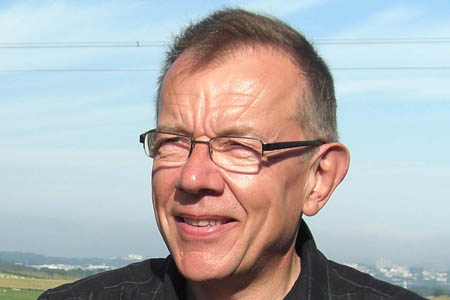Opponents of a proposed windfarm in the Monadhliath Mountains said it would leave the landscape scarred by redundant tracks and land despoiled by concrete and steel at the end of its life.
The Mountaineering Council of Scotland said evidence to the public inquiry into the Allt Duine development, which opens today shows there are no plans to clear up the site after it closes.
There would be 24km (15 miles) of track up to 6m wide on the site, and 31 concrete bases would remain on the hills, each one consisting of 500 tonnes of steel and concrete.
David Gibson, MCofS chief officer, said: “We support green energy generation but this scheme involves dumping 15,500 tonnes of concrete and miles of roads in mountain areas of national importance and beauty.
“Windfarms are supposed to have a lifetime of 25 years. We would therefore expect developers to include proposals for site restitution in their plans as evidence of good stewardship of the environment. This public inquiry should protect our precious natural environment by putting a stop to this completely inappropriate project.”
The MCofS is also concerned that maps being presented to the inquiry by the developers fail to show that their turbines would come within 67m of an area designated by Scottish Natural Heritage as Zone Three: being of such sensitivity that there should be an automatic presumption against wind farms.
Mr Gibson said: “These huge turbines are each 125m high. One is so close to a Zone Three area that if it toppled over it would land inside. This is an area which is so special that wind farm development should not take place. As you might expect we are astonished that the developer has omitted this essential information from their proposal.
“The MCofS does not oppose wind farms, but it is determined to fight hard to protect sensitive areas like the Monadhliath Mountains as these are such important parts of our natural heritage and of economic importance to our tourism industry.
“These proposals would not only have a very real impact on the nearby Cairngorms National Park, which is a jewel in Scotland’s crown of natural beauty, but also be visible from a vast number of Scotland’s mountains across a wide area surrounding the Monadhliath.”
The MCofS speaks for more than 85,000 UK mountaineers on landscape issues in Scotland and is vigorously opposing the Allt Duine proposals, which are among seven schemes that could lead to a total of over 230 turbines, along with huge stretches of service tracks, being built across the central rampart of the Highlands.
The MCofS recently sent its manifesto, Protecting our Mountains, to the First Minister, other MSPs, MPs representing Scottish constituencies and local councillors in eight local authorities.
The document calls for a moratorium on further developments in areas of special sensitivity, such as the Scotland’s highest peaks, the munros and corbetts and seeks the support of elected representatives for the development of a national spatial planning policy for the siting of wind farms
Mr Gibson said: “It’s time for the First Minister to stop dodging the questions about the impact of wind farms on the landscape.
“Platitudes will not protect the landscape for future generations. Our president has asked for a meeting with Scotland’s Environment Minister, Paul Wheelhouse, to discuss our proposals for harmonising the need for clean energy with the protection of our landscape – which is one of Scotland’s greatest cultural and economic assets.
“As yet the Minister has not suggested a date, but we hope that he will recognise that this is a matter of urgency.”
The Cairngorms National Park Authority also opposes German company RWE npower renewables’ plans for the windfarm which is close to the national park boundary.
Other outdoor luminaries have joined the campaign against the Allt Duine development, including writer and journalist Chris Townsend who called it ‘a windfarm too far’.


Richard
23 October 2012All those who think that independence would create a real democracy in Scotland only need to look at these wind farm situations....opposed locally, opposed nationally, even sometimes opposed by government bodies......but passed in Holyrood!
matt
23 October 2012I didn't see MCofS or for that matter much of the Outdoor world stepping up much to challenge the windfarms that are & have been erected across southern Scotland. Why should the quiet and tranquilty of these area be any less valued than the popular honey pots of the North. A wee bit of double standards me thinks. I too agree with green energy but do question some of the carte blanche approach that is runnning rough shod over the country in order to leave a legacy for a certain fish.
Ryan
22 October 2013I am very surprised that there are no plans to reinstate the land after the life span of the turbines, it is common practice to state the decommissioning plans at the application stage. It may even be law.
Another point of the argument is that this country within the Uk has signed up to a European scheme with a target of being 30% reliant on renewable energy by 2020 and also to cut Carbon emissions by 80%. At present the quickest and cheapest way of achieving these tough EU targets is by installing onshore wind. Followed by offshore wind which has higher potential but also higher costs, nuclear has huge power potential but as stated in this weeks media. It will take years for any plant to be commissioned and operational.
Also as Matt says, where we're the MCofS when all the applications flooded in for the south of Scotland, and yes there are still more and more coming in for this already saturated area. Bugger it, let the highlands cop some of it and take the pressure of us southerns for a bit!